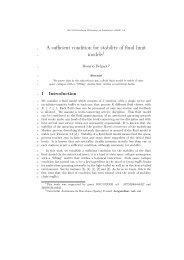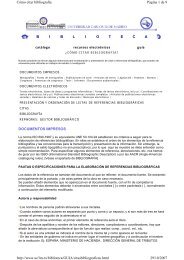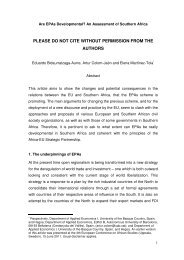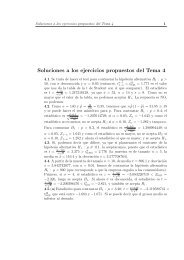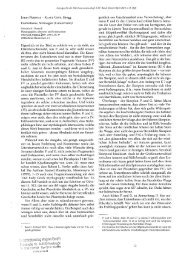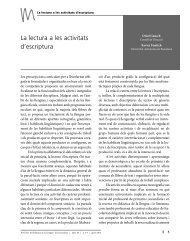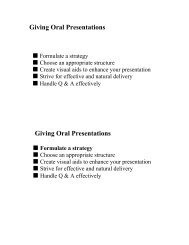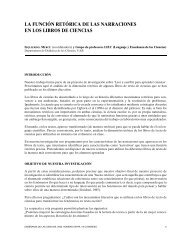J. Theor. Biol. 2006 - PÃ gines de la UAB
J. Theor. Biol. 2006 - PÃ gines de la UAB
J. Theor. Biol. 2006 - PÃ gines de la UAB
- No tags were found...
Create successful ePaper yourself
Turn your PDF publications into a flip-book with our unique Google optimized e-Paper software.
ARTICLE IN PRESS<br />
J.F. Fontanari et al. / Journal of <strong>Theor</strong>etical <strong>Biol</strong>ogy 239 (<strong>2006</strong>) 247–256 251<br />
1<br />
1<br />
0.8<br />
0.25<br />
0.8<br />
0.6<br />
0.5<br />
0.6<br />
2 3 4<br />
g c<br />
0.4<br />
0.2<br />
0.75<br />
0<br />
0 20 40 60 80 100<br />
N<br />
Fig. 2. Critical value of the group selection pressure g c as a function of the<br />
vesicle capacity N for d ¼ 2, s 2 =s 1 ¼ 1:0; 0:75; 0:5 and 0.25 in the case of<br />
error-free replication u ¼ 0. Coexistence of the two temp<strong>la</strong>te types in a<br />
same vesicle is guaranteed above g c . The line for s 2 =s 1 ¼ 1:0 is the fitting<br />
g c ¼ 1=N, the other lines are gui<strong>de</strong>s to eye.<br />
1.0<br />
Ω d<br />
0.4<br />
0.2<br />
2 3 4<br />
0<br />
0 0.2 0.4 0.6 0.8 1<br />
g<br />
Fig. 3. Fraction of vesicles with d ¼ 2; 3 and 4 different types of temp<strong>la</strong>tes<br />
in their composition O d as a function of the group selection pressure g for<br />
N ¼ 24 in the case of error-free replication u ¼ 0. The solid lines are the<br />
results for <strong>de</strong>generate replication rates and the dashed lines are the results<br />
for s 2 =s 1 ¼ 0:8 (d ¼ 2); s 2 =s 1 ¼ 0:8, s 3 =s 1 ¼ 0:6 (d ¼ 3); and s 2 =s 1 ¼ 0:8,<br />
s 3 =s 1 ¼ 0:6, s 4 =s 1 ¼ 0:4 (d ¼ 4).<br />
Fig. 2 which shows the <strong>de</strong>pen<strong>de</strong>nce of the threshold value<br />
g c , below which coexistence is impossible, on the vesicle<br />
capacity N. In the absence of competition (s 2 =s 1 ¼ 1),<br />
coexistence is facilitated by increasing the vesicle capacity<br />
since this attenuates the effect of drift. The data for this<br />
case (lower curve in Fig. 2) are fitted perfectly by the<br />
function g c ¼ 1=N. The situation is more complicated<br />
when competition (s 2 =s 1 o1) is taken into account: after an<br />
initial <strong>de</strong>crease, due to reduction of drift, g c starts to<br />
increase smoothly towards the singu<strong>la</strong>r value g c ¼ 1 as the<br />
vesicle size grows and consequently temp<strong>la</strong>te competition is<br />
enhanced. As has already been said, our formu<strong>la</strong>tion<br />
breaks down if the group selection pressure is set to its<br />
maximum value, since a singu<strong>la</strong>r situation in which all<br />
vesicles are extinct at the same time (i.e. a i ¼ 0 for all i such<br />
that Y i a0) is likely to arise. In fact, this is exactly what<br />
happens in the <strong>de</strong>terministic regime (N !1). Since the<br />
random fluctuations that promote the diversity of the<br />
vesicles are suppressed in this regime, the vesicles soon<br />
become all alike and so group selection is turned off.<br />
Temp<strong>la</strong>te competition is then free to act ending in the<br />
fixation of the fitter temp<strong>la</strong>te in all vesicles regardless of the<br />
value of go1. Note that the singu<strong>la</strong>rity, i.e. the simultaneous<br />
vanishing of the numerator and <strong>de</strong>nominator in<br />
Eq. (6), occurs at g ¼ 1 only. Hence, except for the<br />
<strong>de</strong>generate case s 2 =s 1 ¼ 1, temp<strong>la</strong>te coexistence is impossible<br />
in the <strong>de</strong>terministic regime.<br />
The rich tra<strong>de</strong>-off between drift and competition is<br />
responsible for the appearance of a minimum in the curves<br />
g c vs. N. This minimum disappears for small values of the<br />
ratio s 2 =s 1 indicating that the effect of drift becomes<br />
negligible compared to that of competition. However, in<br />
the probably more realistic case that the temp<strong>la</strong>te replication<br />
rates are almost <strong>de</strong>generate (s 2 =s 1 1), it is the effect<br />
of temp<strong>la</strong>te competition that is negligible, provi<strong>de</strong>d the<br />
vesicle capacity is not too <strong>la</strong>rge. Fig. 3 illustrates the<br />
<strong>de</strong>pen<strong>de</strong>nce of O d on g for a vesicle of fixed size N ¼ 24 and<br />
d ¼ 2; 3 and 4 different temp<strong>la</strong>te types in the <strong>de</strong>generate<br />
case (i.e. s 1 ¼ s s ¼¼s d ) as well as in the more general<br />
situation that all replication rates are different. Regardless<br />
of whether competition is allowed or not, coexistence of<br />
many distinct temp<strong>la</strong>tes can be achieved by increasing the<br />
group selection pressure, though as mentioned before, care<br />
must be taken to avoid the singu<strong>la</strong>r value g ¼ 1. In fact, we<br />
found no evi<strong>de</strong>nce of a threshold on the number of<br />
temp<strong>la</strong>tes beyond which coexistence is preclu<strong>de</strong>d. For<br />
instance, in the extreme case of d ¼ N <strong>de</strong>generate<br />
temp<strong>la</strong>tes, the recursion equations (6) can be solved<br />
analytically, resulting in the simple expression:<br />
O d¼N ¼ 1 <br />
g g 1 d!<br />
d d<br />
<br />
<br />
, (7)<br />
valid for gX1 d! d d . We note that in this region, O d¼N is<br />
a very small quantity, on the or<strong>de</strong>r of expð dÞ for <strong>la</strong>rge d.<br />
So there is no fundamental impediment to the coexistence<br />
of an arbitrary number dpN of distinct temp<strong>la</strong>tes in a<br />
vesicle of capacity N, provi<strong>de</strong>d that the group selection<br />
parameter can be set arbitrarily close, but not equal, to 1.<br />
Of course, as g approaches 1 the fraction of vesicles that<br />
contain all temp<strong>la</strong>te types <strong>de</strong>creases very rapidly and so the<br />
vast majority of the vesicles present in the popu<strong>la</strong>tion will<br />
<strong>la</strong>ck one or more types. Hence, group selection alone<br />
cannot exp<strong>la</strong>in the prevalence of that ‘‘cooperative’’ kind<br />
of vesicle and so one needs to invoke another mechanism to<br />
suppress temp<strong>la</strong>te competition, which will then permit the<br />
rare representatives of the cooperative vesicles (we have<br />
proven that group selection can maintain a few vesicles of<br />
that kind) to take over the vesicle popu<strong>la</strong>tion. The<br />
ingredient missing is probably a selective pressure for




